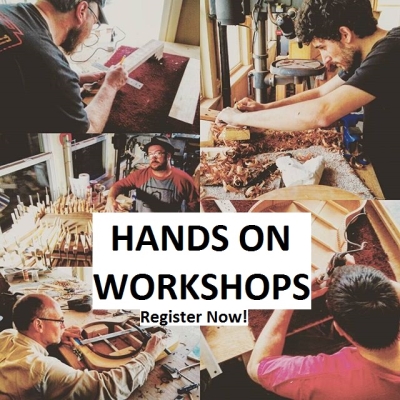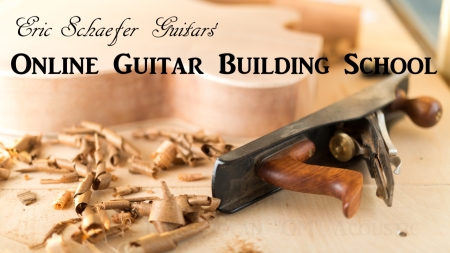In this excerpt from the Online Guitar Building School, I cut and prepare the scarf joint for the headstock.
Video Transcript:
Okay, we are ready to begin work on the neck! From
this single blank of wood I will cut and make the scarf
joint for the headstock and I will also cut and
assemble the blocks for the heel.
I start with a blank of wood, in this case Mahogany,
that is 1″ by 3″.
If this will be your first time hand-carving a neck, I
highly recommend Mahogany for its strength and ease of
use in shaping and carving operations. Other neck woods
may be difficult to work, so you may want to
save that highly figured
The blank should be atleast 32″ in length, although
it can be shorter if you have another blank from which to
cut the blocks for the heel.
Let’s begin by marking the blank for several cuts that
we want to make.
First I square a line 7 1/2″ from one end of the blank.
This marks where the headstock ends and where the nut
begins. This is also where I cut the angle for the scarf
joint, which in this case will be a 15 degree angle.
I pull the squared line onto the sides of the blank.
I pull the squared line onto the sides of the blank,
and use a protractor to mark the 15 degree angle
on both sides.
Then I connect where the two angled lines meet on the
bottom face of the blank. This gives a full representation
of where the angled cut will be on all sides of the blank.
After I make the angled cut for the scarf joint, I will be
thicknessing the offcut to 1/2″, so I will go ahead and
mark that now.
After I make the angled cut for the scarf joint, I will be
thicknessing the offcut to 1/2″, so I will go ahead and
mark that now.
Notice that it is the longer part of the offcut that I will
be thicknessing to 1/2″ and keeping as the headstock.
The shorter portion is waste.
To give you a rough idea of the order of operations here,
first we cut along the angled line for the scarf joint, then
we cut the headstock to thickness
and the remaining piece gets glued
to the bottom of the neck
blank creating what is called a scarf joint for the
headstock.
This is sort of an oversimplification so let’s get into
the details of how to perfect this joint.
Here I am resting the neckblank on the bandsaw table
and checking for square. However, if your bandsaw table
is not square to the bandsaw blade, I would start there
first.
The blank is slightly out of square with the table.
Notice the gap at the bottom of the square.
A few passes on the shooting board with a jack plane
trues up the side.
That’s better. There is a tiny hairline gap at the top
of the square now, but that’s okay. As you’ll see later,
any out of squareness in the cut can be corrected when
we fine-tune the joint.
I prefer to use a 3/8″ blade for this cut. On a 1/4″ blade
the teeth are too fine and the gullets between the teeth
too small to deal with such a heavy cut. Not to mention,
the narrow blade doesn’t track well.
On the other hand, the 1/2″ blade cuts effectively,
and tracks well but it leaves a very coarse surface.
3/8″ seems to be the happy medium.
I set the blade tension for a 3/8″ blade.
I make sure the blade tracks well on the wheel.
And then I set the guide bushings.
I like to set all the bushings so that I can fit a .025″
feeler gauge between the bushing and the blade.
It is always a good idea to have a well set bandsaw.
The table setup, the blade tension, the tracking,
and the guide bushings all factor into the outcome of
the cut.
The last thing I do is set the guide to just barely clear
the workpiece.
The cut is done carefully by hand, working very slowly,
only applying enough pressure to allow the piece to
move forward as the blade clears the wood. Be patient
and do not force it.
Try to keep the blade right on the line. If it drifts, gently
correct it’s course back towards the line.
It is easy to stay on the line if you keep your
focus a short distance ahead of the blade, rather than
right where the blade is cutting.
And now the thickness cut!
I set the table saw fence for a 1/2″ cut. Of course, you
can also make this cut on the bandsaw.
Okay, now let’s fine-tune the joint. I clamp the neck
blank in a vise.
I apply double stick tape to the headstock and
stick the headstock to the neckblank so that the
two angled planes line up.
I clamp two pieces of scrapwood to the sides of the
blank to act as a fence. This makes it easy to stick the
headstock down in proper alignment with the neckblank.
My protractor verifies for me that the angled plane is at
or close to 15 degrees.
The skew of the angled plane can be checked with
a square. Notice the two lines that I am checking:
The line at the top of the angled plane
and the line in the middle where the headstock and
the neckblank meet. If these lines are not
perpendicular to the sides, then the plane is skewed.
I use a block plane, not only to clean up the bandsaw
marks, but also to manage the skew of the angled plane.
As always, it’s not a bad idea to chalk up the surface
so you can see the progress of your work.
I stop to check the two lines with a square.
And then I continue working with the block plane
until all the chalk marks disappear.
Okay, the chalk marks are gone and the lines
are perpendicular to the sides, indicating that the
angled plane is not skewed.
Next, I use sandpaper and a flat
block to remove plane marks and to smooth the surface.
It is always important to make sure that the block
you use is indeed flat.
You’d be surprised how often this is the source of
problems.
This block, by the way, is 3″ by 4 1/4″. That seems to
be a good size for this task.
When sandpaper is pressed between 2 hard surfaces,
the hardwood of the workpiece and the hardwood of
the block, the grit wears down very quickly.
Backing the block with thin cork adds a bit of cushion
to the block which drastically extends the life of the
sandpaper.
Now I attach 120 grit sandpaper
Be sure to trim those loose ends of sandpaper
with a razor blade.
Loose ends have a tendency to leave a slight round to
the edges of your workpiece.
Okay, now that we have an effective sanding block, let’s
chalk up and sand until the marks disappear.
Notice how I sand with a circular motion rather than a
back and forth motion.
With the back and forth technique, the hand has a
tendency to tip slightly every time the hand switches
its momentum from one direction to the other.
The chalk marks are gone, with the exception of this
one stubborn, low spot in the corner. I’m not going to
worry about this spot. The glue joint is actually between
the headstock piece and the bottom of the neckblank.
Finally I finish prepping the surface by sanding to 220
grit.
The last thing I do to prepare the joint is sand the
bottom of the neckblank, where the headstock
will be attached, up to 220 grit.
I use the heatgun and spatula to remove the headstock.
A final check with a straightedge for large gaps, and
we are ready to attach the headstock.
In the next lesson we will attach the headstock and heelblocks.

